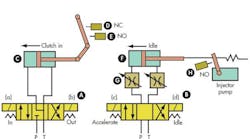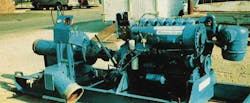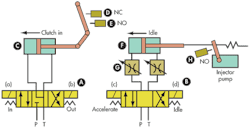Even though I’m now retired, we often used hydraulic clutches in the equipment we designed and built for dredging up and removing sludge from wastewater treatment settling ponds. Disengaging the clutch removes the hydraulic pump from the power train, so it uses zero energy. This not only saves energy over running the pump in standby mode, but also reduces wear and tear on the pump.
Our basic operating unit at Dredging Specialists, Mattoon, Ill., was the Sludge Vac hydraulic dredge. An operator anchors this floating platform at various locations on the pond, and a diesel engine powers a closed-circuit hydrostatic transmission driving a submerged variable-speed centrifugal dredge pump. The sludge is quite viscous, and projects with long pipelines require an onshore booster pump to help move material.
A skid-mounted booster pump assembly consists of a 10-in. centrifugal trash pump coupled via a clutch to a 150-hp diesel engine. The dredge pump typically had to be shut down throughout a typical day to reposition the platform or when debris blocked the pump inlet. Flow from the dredge pump cools the booster pump, so when the dredge is shut down, we needed a control system to also stop the booster pump. Otherwise, excessive heat would quickly damage the rubber parts of the pump’s face-type seal.
Our solution was to design a simple hydraulic system to automatically disengage a clutch and idle the onshore engine whenever necessary. To avoid installing a hydraulic power unit for this low-duty-cycle system, we chose to use the diesel engine’s lubrication system to operate the control. Of course, we were careful not to do anything to compromize the engine’s lube system, and we determined that the low quantity and infrequent need for pressurized oil posed no threat.
Using 40 psi as our design pressure, we selected a 3½-in. bore, agricultural-type hydraulic cylinder to engage and disengage the clutch and a 1¼-in. bore cylinder to control engine speed. (The smaller bore actually was a pneumatic cylinder, but the size was right and we anticipated no problems using oil at 40 psi.) We tapped into the diesel engine on the clean side of the engine oil filter and brought our return line through the timing gear cover. Hose clamps were adequate for our connections in this low-pressure circuit.
Automatic control initially relied on a switch-gauge with low- and high-pressure contacts and a trio of limit switches. The switch/gauge sensed sludge-line pressure at the booster pump inlet, and its contacts directed 12-V ac to three control relays that operate valves A and B shown in the accompanying schematic.
Referring to the schematic, when inlet pressure reaches 5 to 7 psi, the switch/gauge’s high-pressure contacts close to energize solenoid (a). Valve A shifts, and cylinder C engages the clutch. Movement of the overcenter clutch linkage releases limit switches D and E. Switch D de-energizes solenoid (a) and valve A spring centers. Switch E energizes solenoid (c) and valve B shifts to extend speed-control cylinder F, accelerating the diesel engine. (Needle valves G were used for tuning the rate of engine-speed change.)
Acceleration continues as long as the high-pressure contacts on the switch/gage remain closed. When sludge line pressure drops enough to open those contacts, solenoid (C) is de-energized. Valve B spring-centers and its blocked center holds the position of cylinder F to maintain engine speed.
When the floating dredge is shut down, sludge line pressure drops further, and the low-pressure contacts on the switch/gauge close. This energizes solenoid (d) to shift valve B to idle the engine. When cylinder F retracts, the engine’s injector pump actuates limit switch H, which energizes solenoid (b). Valve A shifts, cylinder C extends, and the clutch is disengaged.
We operated this system for several years without experiencing any problems due to use of the engine’s lubricating oil system as our fluid and pressure source. We later upgraded the Sludge Vac with a programmable logic controller. This eliminated the need for four relays and the wiring associated with them.
We continued to use the booster pump until I sold my dredging equipment to WINDALCO, in Jamaica, in 2011. WINDALCO is a large bauxite refinery, which converts bauxite to alumina, which is then made into aluminum.
Since retiring as president of Dredging Specialists Inc., Don Searles continues to do consulting and expert witness work in lawsuits and has completed projects in the U. S. and seven other countries, including Saudi Arabia and India. He has served as an expert witness in more than 30 lawsuits, and is currently working on three. He is also at active in Mattox/Searles Racing, which has an 850 hp, sprint car will race 25 to 30 nights this season. Brandon Mattox is the driver.
This file type includes high resolution graphics and schematics when applicable.




